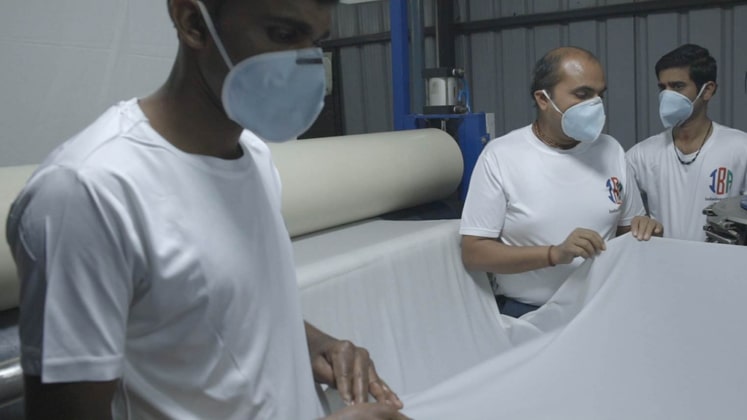Catering to 52 micro seasons a year, preventing excessive production or minimising carbon footprints, the fashion industry is rapidly changing and adapting to new technologies and business models, making it more agile than ever before.
One such technological advancement is on-demand manufacturing, which is expected to reach US $ 112 million by 2024 with a 20 per cent growth yearly. It has transformed the traditional game of bringing products to market based on their research into a pull model where sourcing, production and distribution are based on customer demand, ultimately leading to better control of production, inventory and waste.
Simply put, on-demand manufacturing is a production model in which goods are made after order only, rather than being produced in large quantities and then getting piled up in inventories.
On-demand manufacturing came into existence for several reasons
Firstly, consumers today have higher expectations and are looking for personalised products that enhance their unique style. This has been fuelled by the popularity of e-commerce and social media.
Secondly, the buzzword of sustainability is another driving force behind on-demand manufacturing. The fashion industry, known for its impact on the environment, has contributed to pollution through its traditional manufacturing methods. On-demand manufacturing addresses this problem by producing only what is needed, reducing waste and eliminating the need for excess inventory and unsold items that would end up in landfills.
Additionally, technological advances such as cloud computing, artificial intelligence and the Internet of Things (IoT) have played a critical role in the success of demand-driven manufacturing. These technologies enable faster development, production and delivery of goods. Cloud computing provides easy access to design and production software, while AI algorithms can help predict consumer preferences and optimise production processes. The Internet of Things (IoT) facilitates real-time communication and data exchange between customers, manufacturers and suppliers, streamlining the entire manufacturing and supply chain. Also, the integration of 3D printing and automated manufacturing systems has given the on-demand model an edge.
Asserting this, Vivek Paliwal, Head of Operations, eShakti.com states, “The rise of on-demand manufacturing is driven by consumers’ desire for personalised products, the need for sustainability in the fashion industry and the technological advancements that enable efficient and cost-effective production processes. These factors are interrelated and have created a paradigm shift in manufacturing, offering benefits to both manufacturers and consumers in terms of customisation, waste reduction, cost savings and improved production efficiency.”
Several companies, including Asos, Uniqlo, Boohoo and Zara have embraced this model.
For example, Asos has partnered with digital printing company Kornit Digital to explore the possibilities of on-demand manufacturing. The collaboration allows Asos to leverage the potential of this manufacturing approach. Similarly, Uniqlo has adopted Toyota’s just-in-time (JIT) sourcing methodology, which provides the company with the tools and framework necessary to reduce inventory in its supply chain.
It includes Neems, formerly known as Lasso, a made-to-measure denim company that’s carrying all production in its local factory making all its products ‘Made in USA Freedom Rave Wear’. It specialises in making apparel for rave parties and music festivals using Tukatech solutions alongside its swimwear label and custom fabric printing studio.
Even though, consumers play a significant role in driving the evolution of the fashion collection, advanced technology paves the way and facilitates for an ever more personalised and sustainable offering while being cost-effective.
| eShakti’s in-house inventory system serves as the backbone of our operations aligned to on-demand manufacturing process. With real-time visibility into each style SKU and fabric, we can effectively manage stock levels and ensure the timely availability of materials. This technology empowers us to proactively address any potential shortages or bottlenecks, minimising delays and streamlining our supply chain. By staying on top of inventory management, we can meet customer demands swiftly and efficiently Vivek Paliwal Head of Operations, eShakti.com |
Traditional mass production model is not adapted to smaller product diversity and sustainable demand due to long production lead-time, large quantities and overstocks leading to the recent rise of on-demand manufacturing, more particularly in Italy, France and also in the United-States for luxury brands. For example, in Europe, many premium retailers have chosen Fashion On Demand by Lectra to manage their patterned fabrics more efficiently such as Belles Roches Couture, a high-end tailoring workshop for women’s made-to-measure ready-to-wear world-renowned couture houses such as Emmegi Confezioni, Brioni, Ermenegildo Zegna and Turnbull & Asser. And in the United-States, recently global manufacturer of firefighter PPE Fire-Dex announced an increase of its cutting capacity by 30 per cent with Fashion On Demand by Lectra. Concerning Asia, Hong Kong-based TAL Apparel, one of the world’s largest garment manufacturers and a company whose success is built on innovation, has chosen Fashion On Demand by Lectra to automate their supply chain and accelerate production processes, as part of their made-to-measure business model.
However, an adapted infrastructure is necessary; brands have difficulty in developing multiple independent production workflows the same way they used to do for mass production, too rigid for the creation and manufacture of personalised garments. Technology is the answer to these changes. Indeed, Fashion On Demand by Lectra which is a comprehensive digital solution allows brands to commit swiftly on smaller series with short delivery time at a reasonable price, enabling them to increase their market share. This kind of the production model ‘only produce what is needed’ is more valourised by the market and the transformation of the model can only be completed, thanks to technology.
The end-to-end process of On-Demand manufacturing
Nitin Kapoor, CEO and Co-founder of IBA Crafts Pvt. Ltd., which focuses on just-in-time and on-demand manufacturing models adds that in garment manufacturing, the process begins with designing and prototyping using technology, reducing costs and saving time. Customer orders are crucial as garments are manufactured only after an order is placed, preventing unsold inventory and outdated designs. The TexTech system in the company enables a quick 48-hour manufacturing timeframe, optimising resource utilisation. Quality control measures are implemented to maintain high standards. After passing quality checks, the garment is well-packaged and promptly dispatched to reach the customer on time.
| The introduction of the JITGM system has allowed IBA to adopt an always-in-stock strategy, where garments are manufactured only after the customer has placed an order. This strategy has resonated with consumers who seek personalised and unique products without compromising on sustainable fashion. IBA’s approach addresses the issue of overproduction and the accumulation of unsold inventory, reducing waste and conserving natural resources like water and electricity. Nitin Kapoor CEO and Co-founder of IBA Crafts Pvt. Ltd. |
He also adds, “Implementing on-demand manufacturing, the company addresses challenges such as unsold inventory, outdated designs and wastage of resources. This approach allows for the efficient utilisation of materials, reduces environmental impact and aligns production with customer demand, resulting in a commercially and socially viable process”.
Creating a robust supply chain and managing production capacity with a knack for technology
The success of on-demand manufacturing relies heavily on a strong and dependable supply chain. Manufacturers understand the importance of avoiding delays and keeping inventory levels at zero. To achieve this, they establish effective communication channels with suppliers to ensure the timely and accurate delivery of raw materials. Furthermore, they employ real-time analytics and predictive algorithms to optimise inventory levels and anticipate fluctuations in demand. When faced with high demand periods, manufacturers increase production capacity by utilising modular production systems and flexible workforce arrangements.
“Maintaining a robust raw material supply chain is crucial to our success. Technology plays a vital role in our inventory management and creating a robust supply chain. Our in-house inventory system provides real-time visibility into each style SKU and fabric, enabling effective stock-level management and timely availability of materials. By proactively addressing potential shortages or bottlenecks, we minimise delays and streamline our supply chain. Staying on top of inventory management allows us to meet customer demands swiftly and efficiently and with technology at every level of manufacturing, we optimise efficiency and meet even the tightest deadlines,”adds Vivek.
Additionally, he believes that a Barcode tracking system has also proven to be an advantage that provides end-to-end visibility and control over the production process. From the pattern stage to the cutting stage to the skilled tailors, this system can track each individual order and monitor its progress in real-time. This integration of technology empowers it to expedite urgent customer requests, allocate resources effectively and ensure the timely completion of orders.
Exceptionally bright future with mini smart factories
Start-ups are the frontline for this, squeezing production timelines and streamlining distributions with the knack of nearshoring. The mini and smart factories are going to be the need of time and will be the future of how garment manufacturing will work. With low capital investment, more agility and more flexibility, industry executives expect nearshoring to grow. According to recent survey results published by McKinsey, 60 percent of apparel-procurement executives expect that over 20 percent of their sourcing volume will be from nearshoring by 2025.
The emergence of micro-factories is set to revolutionise the production and distribution of garments. Lesara, a Berlin-based company, exemplifies this trend by manufacturing 90 percent of its products in-house and bringing fashion trends to the market within ten days. Technology companies like Sewbo and Softwear have also made significant contributions by automating sewing processes using robotics. ShareCloth, a New York-based software company, digitises styles and enables retailers to place orders before manufacturing begins, aligning with the on-demand trend.
| Lectra’s cutting equipment and software – offered in SaaS mode since 2018 – now benefit from the power of the cloud, big data, the Internet of Things and artificial intelligence to take advantage of data available at each stage of the value creation chain in which we operate which enables our customers to digitise their cutting rooms and make them more agile for on-demand manufacturing processes Maximilien Abadie Chief Strategy Officer and Chief Product Officer at Lectra |
Leading brands such as Adidas, Superdry, Amazon and Fast Retailing are embracing speed and customisation. Superdry has introduced ‘Superdry Preview’, which delivers limited-edition collections from design to delivery in just six weeks. Amazon has patented a fully automated, on-demand manufacturing system for apparel. Fast Retailing, in collaboration with Shima Seiki, leverages ‘wholegarment’ technology to produce on-demand knitwear at scale, eliminating the need for additional labour.
Prabir Jana, Professor, NIFT highlights several notable examples and believes that their implementation could greatly accelerate the growth of smart factories, particularly within the on-demand manufacturing ecosystem.
Some of these examples include the incorporation of pre-sewing areas equipped with automatic pattern-making capabilities, on-screen digitisers and accessory dispensing systems, all of which significantly reduce time wastage. Additionally, Internet of Things (IoT)-enabled Computer Numerical Control (CNC) cutters have gained prominence, with Tukatech leading the way in developing an automatic pattern-making system. Virtual digitisers simplify the pattern-making process by allowing patterns to be created through photo-based methods. The integration of robots in the sewing area’s pickup section enhances manufacturing processes, improving overall efficiency and productivity. Future prospects include fewer sewing machines and sewbots. Furthermore, the adoption of digital sampling techniques has transformed the traditional sampling process, offering more efficient and cost-effective alternatives. These technological solutions collectively contribute to the advancement of smart manufacturing in the apparel industry.
In addition to Banswara Syntex, Laguna Clothing and Wiintrack Exports, several other factories like RK Industries, Zedex Clothing, Avanti Overseas, Pratibha Syntex, Carnation World and Panorama Apparels have joined the movement of converting their factories into smart factories, embracing the benefits of advanced technologies and innovation in the industry.











